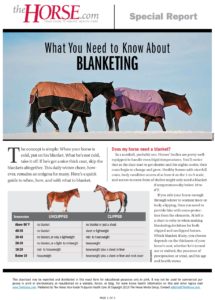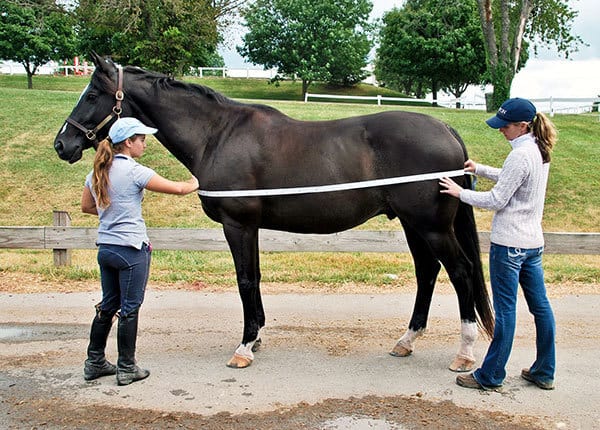Horse Blanketing FAQs

On or off? Hot or cold? Lightweight or heavyweight? We’ll answer these questions and more.
The concept is simple: When your horse is cold, put on his blanket. When he’s not cold, take it off. But how do you really know if he’s cold—short of seeing him shivering in his bell boots? And, if he is, what type of blanket does he need? Will it cause rub marks?
Blanketing doesn’t have to be an enigma. So says two Extension specialists who educate horse owners for a living. Here, they’ll answer your most common equine outerwear questions.
Does my horse need a blanket this winter?
In a nutshell, probably not. Horses’ bodies are pretty well-equipped to handle even frigid temperatures. You’ll notice that as the days start to get shorter and nights cooler—usually around September—their coats begin to change and grow.
“Changes of the hair coat are as much light-dependent as they are temperature-dependent,” explains Bob Coleman, MS, PhD, a former resident of Alberta, Canada, who is now the associate professor of equine Extension at the University of Kentucky’s Department of Animal Sciences, in Lexington.

Healthy horses with nice full coats, body condition scores of at least 4 (on the 1-9 scale, see our Equine Body Condition Score poster), and access to some form of shelter might only need a blanket if temperatures dip below 10° to 0° F, says Karen Waite, MS, PhD, Extension specialist at Michigan State University’s Department of Animal Sciences, in East Lansing.
“If a horse starts to shiver, then you might want to consider a blanket, but typically that doesn’t happen unless (the horse) is cold and wet,” she adds.
But what if my horse is body-clipped?
If you ride your horse enough through winter to warrant trace or body-clipping, then you need to provide him with some protection from the elements.
“Even if they’re inside, if it’s cold in the barn and they’re not moving around much, it might help to give them a little protection to keep the body heat they’re generating in,” says Coleman.
Throw a light- or midweight blanket on your body-clipped horse when temperatures start to hit the 40s, and reach for a heavier one once temperatures dip below freezing.
Startled by Shock?
Dry winters can make blanketing pretty shocking. “Using fabric softener or static guard on blankets can help, as can smoothing the horse’s hair with a dryer sheet (preferably something for babies or sensitive skin),” says Karen Waite, MS, PhD, equine Extension specialist at Michigan State University’s Department of Animal Sciences. “Taking the blanket off and putting it on over the horse’s head, rather than dragging the blanket over the body too much can also help avoid this problem.”
What do you mean by light-, mid-, or heavyweight?
Herein lies the reason why our horses often have wardrobes that rival our own. Blanket manufacturers categorize their blankets according to insulation factor as light-, mid-, or heavyweight to cater to a wide range of temperatures and management factors.
“Typically, the greater (heavier) the fill, the warmer the blanket,” says Waite. “Knowing which blanket to select is going to depend on your horse’s coat, condition, the environment, and how they are managed (indoors vs. outdoors, etc.).”
Fortunately, blanket manufacturers usually provide guidelines as to which of their blankets you should use in what circumstances, so ask about these when buying.

What size blanket does my horse need?
The answer to this one is a little more cut-and-dried. To calculate your horse’s blanket size, stand him square and place a measuring tape in the center of his chest, just below the spot where the neck joins the body, says Waite. Recruit a helper to pull the tape around the chest and the widest part of the shoulder and along the side of the horse’s body to the point of the buttocks, about 10 inches below the tailhead, she says. This length in inches will correlate to your horse’s blanket size. (Tip: Go to a fabric or hardware store and buy a long tape measure that will run the length of your horse, says Coleman.)
“Blanket sizes are typically pretty standard, but there may be slight differences between brands,” notes Waite. “It would be wise to check with the manufacturer to see if they suggest anything different when measuring.” Sometimes online retailers have customer product reviews that can shed light on sizing (these sheets run big, this blanket fit my draft better than my light-breed horse, etc.).
When fitting a blanket, make sure any leg straps are secure, and condition your horse to wearing the blanket in his stall before turning him out with it, says Coleman. Don’t wait until he’s tearing around an icy paddock to find out that fasteners and flaps bother him!
How do I know if my horse is getting too warm under his blanket?
If your horse is starting to sweat under his blanket, he’s too hot. But this isn’t always obvious, so look for the subtle signs.
On cold days, for instance, horses naturally gravitate toward sunlight. This strategy for warming up is effective—enough that you might notice steam coming off the front of the blanket or around the horse’s withers. In those cases, they’re getting too hot, says Coleman, and it’s not necessarily the extra heat that’s the issue; it’s the damp.
“Once the sun goes down, they’re going to be wet, and they’re going to be cold, and they’ll start to shiver,” Coleman says. He likens it to how you’d feel if you worked up a sweat mucking out stalls in a down coat and then walked outside into the cold: “Your insulated materials are now damp, and you get cold faster. Horses are the same way.”
Blanketing Cheat Sheet
Use this guide as a reference when making blanketing decisions. Which blanket, if any, you choose depends on the thickness of your horse’s clipped or unclipped coat, whether he’s turned out or stabled, the presence of precipitation or wind, and his age and health status.
| Temperature | Unclipped | Clipped |
| Above 50° F | no blanket | no blanket or just a sheet |
| 40-50° F | no blanket | sheet or lightweight |
| 30-40° F | no blanket, or only a lightweight | mid- to heavyweight |
| 20-30° F | no blanket, or a light- to midweight | heavyweight |
| 10-20° F | mid- to heavyweight | heavyweight plus a sheet or liner |
| Below 10° F | heavyweight | heavyweight plus a sheet or liner or neck cover |
Will blanketing my horse one winter prevent him from growing a good coat the next?
Nope. Our sources agree that there’s no merit to this old wives’ tale. Like clockwork, the change in seasons and shorter days cause your horse’s body to begin preparing for the cold months ahead.
“I’ve seen lots of horses that have had blankets on, and when you turn them out (the following winter) they turn into Thelwell ponies, as happy as can be,” says Coleman.
My horse is moving to a different climate mid-winter; what do I do?
Obviously, a horse moving north will have a more difficult transition than the horse moving south.
In the event of a mid-winter move north, “Horses that do not have winter coats should be blanketed, hooded, and closely watched for shivering, weight loss, etc.,” says Waite. “These horses will be very susceptible to cold and will need appropriate shelter, especially the first year.”
Coleman suggests investing in a blanket with a higher insulation factor if you’re heading to colder climes. On the flipside, “If we’re going from Canada to Florida in December, the horse might have a bit of a hair coat,” he says. “You might need to decrease the insulation value or take the blanket off altogether,” or even body clip him if he’s miserably hot.
“The nice thing is that horses acclimate very quickly,” Coleman adds. “If we change their hair coat growth, give them a year and they’ll figure it out. Biologically, they’re pretty adept at growing hair.”
Deciphering Blanket Jargon
- Cordura – This tough, mildew- and water-resistant synthetic nylon is popular for turnout rugs.
- Denier – This measure of nylon fiber density indicates a blanket’s durability and water resistance. The higher the denier, the hardier it is. Look for a denier upward of 1200 in turnout rugs.
- Gusset – These pleatlike like triangles of fabric sewn into the shoulder area of your horse’s blanket allow more freedom of movement.
- Hood – Body-clipped horses, competition horses, or horses living in extreme winter climates might benefit from a hood or neck cover for extra warmth and/or even hair growth.
- Lining – Blanket linings are made with a variety of materials, such as cotton, nylon, and mesh. Cotton or poly linings are warm and absorbent, while mesh, for instance, is cool and breathable.
- Liners – (different from linings, which are built in) These also come in a variety of weights and fill materials.
- Sheet – Horses can wear these versatile lightweight blankets in mild weather, in layers under thicker blankets, or to stay clean in the barn.
- Surcingle – Most blankets have two or three or these straps that run beneath the belly to help hold the blanket in place. Metal clasps attach them to the side of the blanket.
- Weight – The amount of polyester fill, by grams, the blanket offers as insulation. Fill can range from 0 g in a lightweight blanket to upward of 400 g in heavyweights.
—Alexandra Beckstett
Does a foal born in winter need a blanket?
Whether a February foal needs a blanket depends on his environment. For instance, don’t be rushing out to buy a blanket for the newborn foal housed in a well-bedded stall protected from the wind, Coleman says.
“If they are in a heated barn they may not need a blanket, but more often than not, foals born in the winter will benefit from blankets so as to not lose body heat,” says Waite. “Foals born in the winter in northern climates are typically kept indoors and turned out for short periods, usually with a blanket.”
Does my senior horse need a blanket?
Horses go through some biologic changes as they age that might prompt owners to blanket them. Many don’t have the muscle bulk and fat stores they did in their prime, and so they drop in body condition score. Coleman suggests blanketing senior horses that have scores lower than 5, particularly to protect them from the wind.
“Those horses that are a little thinner are going to grow a much different hair coat,” he explains. “It’s going to be longer, a little rougher, but not thicker.”
How do I prevent those ugly rub marks?
Buy a blanket that fits! Measure your horse as described on the previous page to ensure his blanket fits and make adjustments as needed.
“Blanket liners and shoulder protectors will also help prevent this problem,” Waite says. “You should be able to easily slide your hand under the blanket and up the shoulder. If it pinches or is tight in this or any area, rubbing may occur.”
Take-Home Message
As it turns out, blanketing is actually a pretty big responsibility. “It’s not a matter of just blanketing your horses and letting them go,” says Waite. “You have to make sure blankets don’t get wet, change them when they do, and check them daily.”
“We put blankets on, don’t make sure they fit right, don’t make sure they’re staying dry, and we wonder why they don’t work,” adds Coleman. Also, keep in mind that “just because the blanket’s on doesn’t mean you don’t have to pull it off and look at the horse every day.”
So make sure your horse’s blanket fits, keep a constant eye on his body condition and the weather, and hoist it on or off as needed, remembering that you get to burn a few calories each time you do!

Written by:
Alexandra Beckstett
Related Articles
Stay on top of the most recent Horse Health news with















